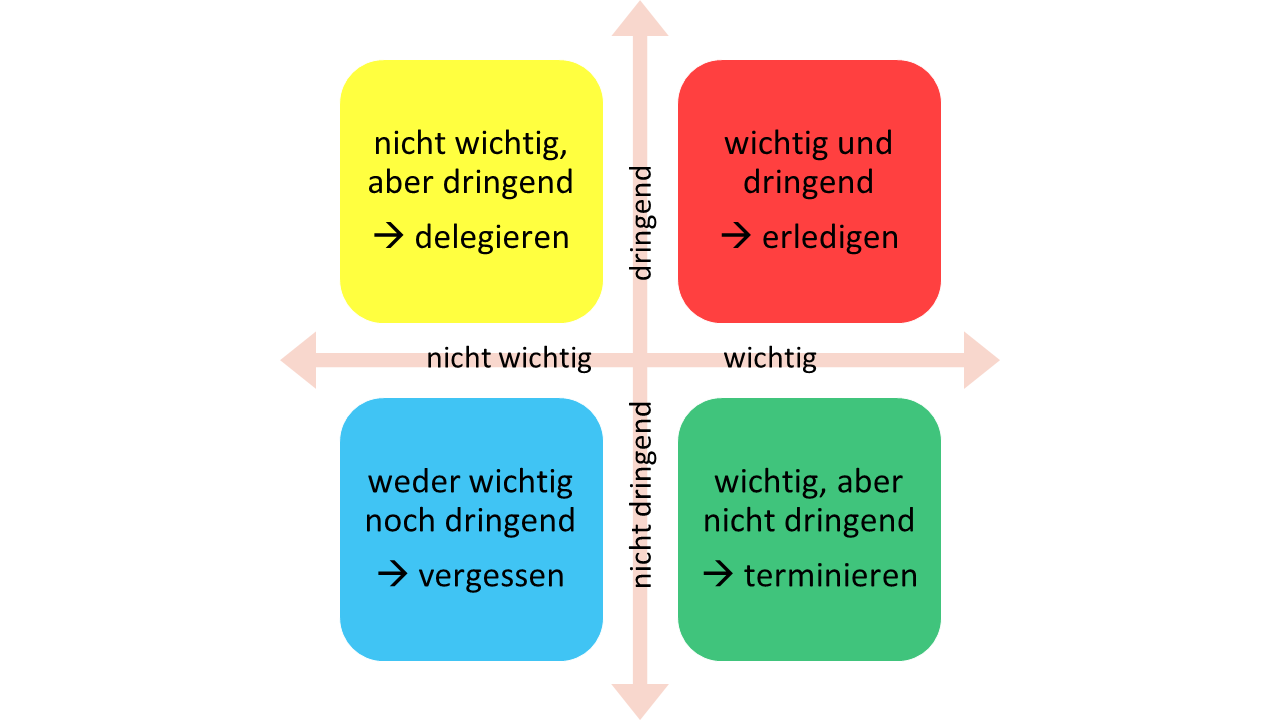Tasks and Goals in Harmony
This approach helps you stay organized and focus on what truly matters!
Tasks and Goals in Harmony
Every day has 24 hours. In these 24 hours, we have appointments, agreements, work, and personal tasks. We also want time for leisure, breaks, recovery, and sleep. Plus, there are things we want to achieve over time. How can we manage all this? What do we need to complete our tasks and reach our goals?
Define Tasks
We start with a classic to-do list, noting all our tasks, regardless of when they're planned.
| Tasks & Goals |
|---|
| ⬜ Task 1 |
| ⬜ Task 2 |
| ⬜ Task 3 |
| ⬜ Task 4 |
| ⬜ Task 5 |
Schedule Tasks
We assign each task a latest completion date. Tasks without a date go on a separate list.
| Scheduled | Not Scheduled |
|---|---|
| ⬜ Task 1 – Today | ⬜ Task 2 |
| ⬜ Task 3 – Today | ⬜ Task 6 |
| ⬜ Task 4 – 22.05. | ⬜ Task 7 |
| ⬜ Task 5 – 01.07. | ⬜ Task 8 |
Mark Recurring Tasks
Regular tasks get a recurrence rate (e.g., every 1st, every 2nd Friday, daily).
| Scheduled | Cycle | Not Scheduled |
|---|---|---|
| ⬜ Task 1 – Today | ⬜ Daily | ⬜ Task 2 |
| ⬜ Task 3 – 01.06. | ⬜ Every 1st of Month | ⬜ Task 6 |
| ⬜ Task 4 – Today | ⬜ Every Thursday | ⬜ Task 7 |
| ⬜ Task 5 – 22.05. | ⬜ Task 8 | |
| ⬜ Task 9 – 01.07. | ||
| ⬜ Task 10 – Today | ||
| ⬜ Task 11 – 13.05. |
Daily Categorization and Prioritization
We've prioritized tasks by time, knowing what to do today, tomorrow, and later.
Now, we categorize tasks by importance. We use the Eisenhower Matrix to decide daily priorities.
The Eisenhower Principle
The Eisenhower Principle helps collect and prioritize tasks. It categorizes tasks by urgency and importance. Tasks fit into four areas:
- Important and urgent
- Not important but urgent
- Important but not urgent
- Neither important nor urgent
Within each category, further prioritization is possible. It's usually impractical to do multiple tasks at once.

1. Important and Urgent
Tasks here should be done immediately and personally. We list tasks for today that need our attention.
2. Not Important but Urgent
Urgent but not important tasks should be delegated if possible. If not, do them after important and urgent tasks.
3. Important but Not Urgent
Tasks here need a completion date and should be done personally. Move tasks not scheduled for today here.
4. Neither Urgent nor Important
Decide if tasks here might become urgent or important. If so, "forget" them until their status changes. Otherwise, delete them. Place unscheduled tasks here.
Consider Goals
We've created an Eisenhower Matrix with all tasks. But we also have goals. Let's integrate them into our matrix.
How Do Goals Relate to Tasks?
You might wonder about goals and tasks and their difference. A goal is a state we want to achieve. Examples include:
- Climbing a mountain
- Losing 10 kilos
- Skydiving
- Getting married
- Earning €10,000 monthly
All goals require tasks to achieve them. Goals remind us why we do or don't do things.
Collect Goals
First, collect all goals, regardless of type. The result should look like our initial to-do list. Specific goals increase achievement chances. The SMART method helps define goals.
Schedule Goals
Next, determine if goals are short-term, mid-term, long-term, or life goals. Base this on the timeline for achieving them.
- Short-term: ≤ 1 year
- Mid-term: ≤ 5 years
- Long-term: ≤ 10 years
- Life goals: > 10 years
Regularly check if goals or circumstances change. This could be a recurring task in the Eisenhower Matrix.
| Short-term (≤ 1 Year) | Mid-term (≤ 5 Years) | Long-term (≤ 10 Years) | Life Goals (> 10 Years) |
|---|---|---|---|
| ⬜ Short-term Goal 1 | ⬜ Mid-term Goal 1 | ⬜ Long-term Goal 1 | ⬜ Life Goal 1 |
| ⬜ Short-term Goal 2 | ⬜ Mid-term Goal 2 | ⬜ Long-term Goal 2 | ⬜ Life Goal 2 |
| ⬜ Short-term Goal 3 | ⬜ Mid-term Goal 3 | ⬜ Long-term Goal 3 | ⬜ Life Goal 3 |
| ⬜ Short-term Goal 4 | ⬜ Long-term Goal 4 |
Link Goals and Tasks
To achieve goals, ensure at least one scheduled task per goal. For example, if the goal is to lose 10 kilos in 12 months, include daily exercise in your task plan.
Conclusion
We've explored structuring, organizing, and prioritizing tasks and goals.
You can plan time by the hour, but this often fails. Priorities change, or you're not as productive as usual.
This approach achieves a lot:
- Awareness of personal goals
- Increased chance of achieving goals
- Sorting tasks by importance and urgency
- Action plan for each task
- Flexible, expandable task list
- One-time effort, lasting benefit
- Handles recurring and complex tasks
How do you align your tasks and goals?
